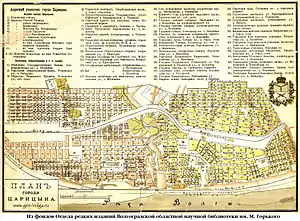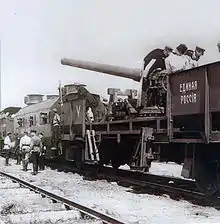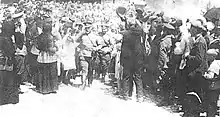Battle of Tsaritsyn
The Battle of Tsaritsyn was a military confrontation between the successful Bolshevik forces and the White Army during the Russian Civil War for control of Tsaritsyn (now Volgograd), a significant city and port on the Volga River in southwestern Russia.
| Battle of Tsaritsyn | |||||||
|---|---|---|---|---|---|---|---|
| Part of the Southern Front of the Russian Civil War | |||||||
 A 1913 map of Tsaritsyn | |||||||
| |||||||
| Belligerents | |||||||
|
Supported by: |
| ||||||
| Commanders and leaders | |||||||
|
|
| ||||||
| Strength | |||||||
|
| At least 160,000 2 Armoured Cars | ||||||
| Casualties and losses | |||||||
| 130,000 | 80,000 | ||||||
Background
The battle started when the White Army, under Ataman Pyotr Krasnov, laid siege to Tsaritsyn in the autumn of 1918. They pushed back the Red Army's defenders into areas surrounding the town on the west bank. The local Bolshevik leaders desperately called Moscow for reinforcements and arms but received nothing other than orders to stand firm.
Battle
Andrei Snesarev was charged with defending Tsaritsyn by Vladimir Lenin, and upon arriving in May 1918, he began assembling a defense. Upon the arrival of Joseph Stalin in June 1918, who had initially been sent to obtain grain for Moscow, he immediately demanded military powers as well in insubordination of the war commissariat, headed by Leon Trotsky. Having eventually gotten Trotsky's permission to decide military matters, Stalin had Snesarev arrested and took over the command, with Kliment Voroshilov as his aide.[2]
Over the course of the battle, Stalin regularly disobeyed Moscow's orders, illegally confiscated supplies sent from Moscow through Tsaritsyn to further south, the Caucasus. Over such conflicts and because of the insubordination of Trotsky, Stalin was recalled from Tsaritsyn and relieved of his post by Lenin in October 1918. He was replaced by Trotsky.[3] However, the city was surrounded by White forces, and it took Dmitry Zhloba's "Steel Division" of 15 000 men for a quick advance from Caucasus to surprise the Whites with a rear attack. Three major engagements then developed around the city afterwards during the entire duration of the battle, but they were likewise less successful than the first one.
The troops of White General Anton Denikin temporarily took over the city in June 1919. Major Ewen Cameron Bruce of the British Army had volunteered to command a British tank mission assisting the White Army and was awarded the Distinguished Service Order[4] for his bravery during the June 1919 battle for single-handedly storming and capturing the fortified city of Tsaritsyn, under heavy shell firein a single tank, which led to the successful capture of over 40,000 prisoners.[5] The fall of Tsaritsyn is viewed "as one of the key battles of the Russian Civil War" and greatly helped the White Russian cause.[5] The noted historian B. H. Liddell Hart commented that Bruce's action is "one of the most remarkable feats in the whole history of the Tank Corps."[6]
However, Red Army forces under Stalin and Voroshilov, strengthened by supplies and weapons that had recently arrived from Moscow, staged an all-out assault towards the city and retook it by January 1920. As a result, the defeated White Army, now in danger of destruction, then retreated toward the Crimean Peninsula.
Repressions
During the battle, the locally-created Cheka carried out a ruthless repression campaign targeting those deemed to be bourgeoisie, clergy, intelligentsia or tsarist officers, many of whom had answered a local appeal to join the Red Army.[7] Victimized were also those who would question the policy. Stalin, having been granted military powers in the city, proceeded to arrest the current Red Army general Snesarev and tsarist officers and specialists who were already serving in the Red Army and had them detained on a barge on the Volga River. The eventual fate of the prisoners was starvation or execution except for Snesarev, who was freed on Trotsky's orders and reassigned elsewhere.[8]
Stalin had also intrigued to confiscate from his colleagues K.E. Makhrovsky, who had been sent by Lenin to obtain fuel, money, fuel, train and had his assistant, N.P. Alekseev, his transport commissariat, shot along with his two sons without a trial in connection with an alleged plot.[9] Makhrovsky was also arrested but was eventually released.
The executions and the alleged plots were broadcast in newspapers in an attempt to galvanize the public. That may have been the first instance revealing the future leader's proclivity to unveiling numerous plots and conspiracies and entangling the victims into fabricated and publicized trials for agitation purposes.[10] According to Anatoly Nosovich, a Red Army defector, Stalin "frequently remarked in arguments over the military arts [...] if the most talented commander in the world lacked politically conscious soldiers properly prepared by agitation, then, believe me, he would not be able to do anything against revolutionaries who were small in number but highly motivated."[9]
The local soviet attempted to investigate the ongoing arrests and executions but was told off by the local Cheka.[9]
Aftermath
For these and later actions in the city of Tsaritsyn region,the city was renamed Stalingrad in 1925 to honor Stalin. A little over two decades later the city would once again be a battlefield, this time for the decisive battle of the Eastern Front of World War II, the bloody Battle of Stalingrad. The city was renamed in 1961 to Volgograd by Nikita Khrushchev during his de-Stalinization campaign.
Gallery
 Mitrofan Grekov's painting of an attack in Tsaritsyn
Mitrofan Grekov's painting of an attack in Tsaritsyn Grekov's painting of Stalin, Voroshilov and Shchadenko in the trenches of Tsaritsyn
Grekov's painting of Stalin, Voroshilov and Shchadenko in the trenches of Tsaritsyn Painting of the Red Army on their way to Tsaritsyn
Painting of the Red Army on their way to Tsaritsyn White Army armoured train "United Russia" on its way towards the city, June 1919
White Army armoured train "United Russia" on its way towards the city, June 1919 Local citizens welcome Denikin and officers to the city on 1 July 1919
Local citizens welcome Denikin and officers to the city on 1 July 1919 Denikin and Wrangel during a Tsaritsyn parade with Armed Forces of South Russia in July 1919
Denikin and Wrangel during a Tsaritsyn parade with Armed Forces of South Russia in July 1919
References
- Damien Wright, Churchill's Secret War with Lenin: British and Commonwealth Military Intervention in the Russian Civil War, 1918-20, Solihull, UK, 2017, p. 397
- Stephen, Kotkin. "Stalin: Paradoxes of Power". Penguin Press: 2014, p. 301-303.
- Stephen, Kotkin. "Stalin: Paradoxes of Power". Penguin Press: 2014, p. 309-310.
- Distinguished Service Order citation for Bruce in the 1920 London Gazette
- Kinvig, Clifford. "Churchill's Crusade: The British Invasion of Russia, 1918-1920". Hambledon Continuum: 2006, p. 225; ISBN 9781847250216.
- Liddell Hart, Basil. "The Tanks: The History Of The Royal Tank Regiment And Its Predecessors, Heavy Branch Machine-Gun Corps, Tank Corps And Royal Tank Corps, 1914-1945. Vol I". Cassell: 1959, p. 211.
- Stephen, Kotkin. "Stalin: Paradoxes of Power". Penguin Press: 2014, p. 302.
- Stephen, Kotkin. "Stalin: Paradoxes of Power". Penguin Press: 2014, p. 302-304.
- Stephen, Kotkin. "Stalin: Paradoxes of Power". Penguin Press: 2014, p. 305.
- Stephen, Kotkin. "Stalin: Paradoxes of Power". Penguin Press: 2014, p. 306.
- R. Overy, Why the Allies Won, London 1996
- S. Kotkin, 'Stalin: Paradoxes of Power', 2014